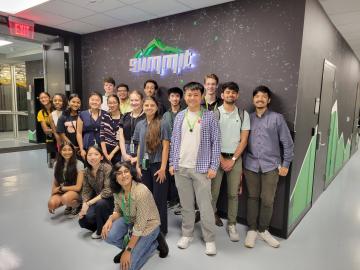Filter News
Area of Research
- (-) Biology and Environment (119)
- (-) Supercomputing (172)
- Advanced Manufacturing (7)
- Biological Systems (3)
- Biology and Soft Matter (4)
- Building Technologies (3)
- Chemical and Engineering Materials (3)
- Chemistry and Physics at Interfaces (7)
- Clean Energy (208)
- Climate and Environmental Systems (7)
- Computational Biology (1)
- Computational Chemistry (5)
- Computational Engineering (2)
- Computer Science (4)
- Data (1)
- Earth Sciences (1)
- Electricity and Smart Grid (2)
- Energy Frontier Research Centers (7)
- Energy Sciences (2)
- Fuel Cycle Science and Technology (2)
- Functional Materials for Energy (10)
- Fusion and Fission (43)
- Fusion Energy (7)
- Geographic Information Science and Technology (1)
- Isotopes (24)
- Materials (186)
- Materials Characterization (2)
- Materials for Computing (17)
- Materials Synthesis from Atoms to Systems (8)
- Materials Under Extremes (8)
- National Security (53)
- Neutron Data Analysis and Visualization (2)
- Neutron Science (83)
- Nuclear Science and Technology (35)
- Quantum Condensed Matter (3)
- Quantum information Science (5)
- Renewable Energy (2)
- Sensors and Controls (2)
- Transportation Systems (6)
News Type
News Topics
- 3-D Printing/Advanced Manufacturing (6)
- Advanced Reactors (1)
- Artificial Intelligence (27)
- Big Data (18)
- Bioenergy (30)
- Biology (49)
- Biomedical (16)
- Biotechnology (7)
- Buildings (3)
- Chemical Sciences (9)
- Clean Water (8)
- Climate Change (34)
- Composites (2)
- Computer Science (57)
- Coronavirus (11)
- Critical Materials (1)
- Cybersecurity (5)
- Decarbonization (17)
- Energy Storage (7)
- Environment (70)
- Exascale Computing (16)
- Frontier (16)
- Fusion (1)
- Grid (2)
- High-Performance Computing (34)
- Hydropower (5)
- Isotopes (2)
- Machine Learning (11)
- Materials (15)
- Materials Science (16)
- Mathematics (3)
- Mercury (6)
- Microscopy (11)
- Molten Salt (1)
- Nanotechnology (12)
- National Security (5)
- Net Zero (2)
- Neutron Science (9)
- Nuclear Energy (3)
- Partnerships (1)
- Physics (5)
- Polymers (2)
- Quantum Computing (11)
- Quantum Science (11)
- Renewable Energy (1)
- Security (2)
- Simulation (18)
- Software (1)
- Space Exploration (2)
- Summit (24)
- Sustainable Energy (20)
- Transformational Challenge Reactor (1)
- Transportation (5)
Media Contacts

ORNL Environmental Sciences Division Director Eric Pierce presented the division’s 2023 Distinguished Achievement Awards at the organization’s December all-hands meeting.

A team of computational scientists at ORNL has generated and released datasets of unprecedented scale that provide the ultraviolet visible spectral properties of over 10 million organic molecules.

Research performed by a team, including scientists from ORNL and Argonne National Laboratory, has resulted in a Best Paper Award at the 19th IEEE International Conference on eScience.

This summer, ORNL welcomed more than 500 students to campus through the lab’s range of internship programs, which are offered in areas such as biology, national security and computing.

ORNL's Climate Change Science Institute and the Georgia Institute of Technology hosted a Southeast Decarbonization Workshop in November that drew scientists and representatives from government, industry, non-profits and other organizations to

Scientists at ORNL used their knowledge of complex ecosystem processes, energy systems, human dynamics, computational science and Earth-scale modeling to inform the nation’s latest National Climate Assessment, which draws attention to vulnerabilities and resilience opportunities in every region of the country.

How the Frontier team broke the exascale barrier to launch a new supercomputing era for scientific discovery.

The team that built Frontier set out to break the exascale barrier, but the supercomputer’s record-breaking didn’t stop there.

Making room for the world’s first exascale supercomputer took some supersized renovations.

Researchers used the world’s first exascale supercomputer to run one of the largest simulations of an alloy ever and achieve near-quantum accuracy.




